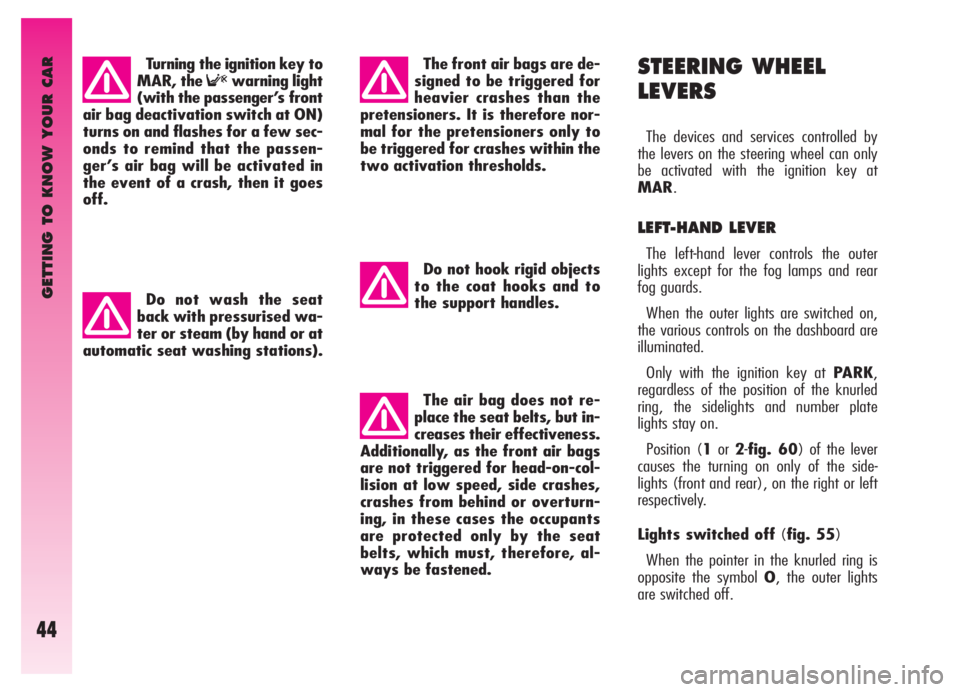dashboard warning lights Alfa Romeo GT 2005 Owner handbook (in English)
[x] Cancel search | Manufacturer: ALFA ROMEO, Model Year: 2005, Model line: GT, Model: Alfa Romeo GT 2005Pages: 307, PDF Size: 6.05 MB
Page 15 of 307

GETTING TO KNOW YOUR CAR
13
WHEN THE ALARM
IS TRIGGERED
When the system is on, the alarm comes
into action in the following cases:
– opening of one of the doors, bonnet or
tailgate;
– disconnection of the battery or sec-
tioning of electric cables;
– intrusion in the passenger compart-
ment, for example breakage of windows
(volumetric protection);
– attempt to start the engine (key in
MARposition);
– abnormal car lifting/sloping (for ver-
sions/markets where applicable).
Depending on the markets, the cutting in
of the alarm causes operation of the siren
and hazard warning ligths (for about 26
seconds). The ways of operating and the
number of cycles may vary depending on
the markets.
A maximum number of cycles is howev-
er envisaged.
Once the alarm cycle has ended, the sys-
tem resumes its normal control function.
VOLUMETRIC PROTECTION
To make sure that the protection system
works correctly the side windows and sun-
roof (if fitted) must be properly shut.
The function can be cut off (if, for exam-
ple, leaving animals in the car) carrying
out the following operations in rapid suc-
cession: starting from the condition with
the ignition key at MAR, move the key
toSTOP, then immediately back to
MARand then to STOPagain, then
remove the ignition key.
The deterrent led (A-fig. 7) on the
dashboard lights up for about 2 seconds to
confirm that the function has been cut off.
To restore volumetric protection, move
the and keep the ignition key at MARfor
over 30 seconds.
If, with the volumetric protection func-
tion deactivated, an electric control con-
trolled by the ignition key at MAR(e.g.
power windows) turn the ignition key to
MAR, operate the control and move the
key to STOPin a maximum time of 30
seconds. This way volumetric protection is
not restored.
HOW TO CUT OFF
THE ALARM SYSTEM
To deactivate the alarm system com-
pletely (for instance during prolonged
inactivity of the vehicle) simply lock the
car turning the key in the lock.
MINISTERIAL CERTIFICATION
In accordance with the law in force in
each country, on the subject of radio fre-
quency, we wish to point out that for the
markets in which the transmitter needs to
be marked, the certification number is
given on the component.
Depending on the versions/markets, the
code may also be given on the transmitter
and/or on the receiver.
Page 46 of 307

GETTING TO KNOW YOUR CAR
44
STEERING WHEEL
LEVERS
The devices and services controlled by
the levers on the steering wheel can only
be activated with the ignition key at
MAR.
LEFT-HAND LEVER
The left-hand lever controls the outer
lights except for the fog lamps and rear
fog guards.
When the outer lights are switched on,
the various controls on the dashboard are
illuminated.
Only with the ignition key at PARK,
regardless of the position of the knurled
ring, the sidelights and number plate
lights stay on.
Position (1or2-fig. 60) of the lever
causes the turning on only of the side-
lights (front and rear), on the right or left
respectively.
Lights switched off(fig. 55)
When the pointer in the knurled ring is
opposite the symbol O, the outer lights
are switched off. Turning the ignition key to
MAR, the
Fwarning light
(with the passenger’s front
air bag deactivation switch at ON)
turns on and flashes for a few sec-
onds to remind that the passen-
ger’s air bag will be activated in
the event of a crash, then it goes
off.The front air bags are de-
signed to be triggered for
heavier crashes than the
pretensioners. It is therefore nor-
mal for the pretensioners only to
be triggered for crashes within the
two activation thresholds.
Do not hook rigid objects
to the coat hooks and to
the support handles.
The air bag does not re-
place the seat belts, but in-
creases their effectiveness.
Additionally, as the front air bags
are not triggered for head-on-col-
lision at low speed, side crashes,
crashes from behind or overturn-
ing, in these cases the occupants
are protected only by the seat
belts, which must, therefore, al-
ways be fastened. Do not wash the seat
back with pressurised wa-
ter or steam (by hand or at
automatic seat washing stations).
Page 47 of 307

GETTING TO KNOW YOUR CAR
45
Sidelights(fig. 56)
The sidelights are switched on by turning
the knurled ring from Oto
6.
The
3warning light on the instrument
cluster will come on at the same time.
Dipped-beam headlights (fig. 57)
These are switched on by turning the
knurled ring from
6to2.
fig. 55
A0A0063b
fig. 56
A0A0064b
Main beams (fig. 58)
To turn the main beams on, set the
knurled ring to position
2and push the
lever towards the dashboard (stable posi-
tion); warning light
1on the instrument
panel will turn on.
To set dipped-beams back pull the lever
towards the steering wheel.
fig. 57
A0A0065b
fig. 58
A0A0066b
When the dipped beam headlights and
the fog lamps are switched on, the outer
light control unit (integrated in the Body
Computer) works according to the follow-
ing logics:
– turning on the main beams, the
dipped beams turn off while the fog lamps
stay on, when restoring the starting con-
dition at dipped beam setting;
or
– turning on the main beams, the fog
lamps turn off and then turn on again
automatically as the main beams are
switched off.
Therefore, in the event of Body
Computer replacement, the outer light
operating logic may be different.
fig. 59
A0A0067b
Page 295 of 307

INDEX
293
- refuelling ............................... 198
Fuel consumption ........................ 286
Fuel flap .................................... 198
Fuses ........................................ 236
Gearbox lever ............................ 127
Getting to know your car.... 6
Glass holder ......................... 141-142
Glove compartment ..................... 138
Glove compartment light
- changing bulbs ....................... 234
Handbrake ................................ 126
Hazard warning lights .................. 124
Headlamp beam adjustment ......... 148
Headlight washers ................ 49-267
Headlights
- adjustment abroad .................. 148
- beam adjustment .................... 148
- changing bulbs ................. 221-224
- compensation for tilt ......... 148-149
Headrests (front/rear) .......... 18-21Horn ......................................... 52
Hoses ........................................ 265
Ignition device ............................ 14
Ignition switch and steering lock 14-15
In an emergency..................... 210
In the event of an accident ........... 246
Inertial fuel cut off switch ............. 125
Instrument cluster ................. 53-54
Instrument lighting adjustment ...... 59
Intelligent washing (windscreen) ... 47
Interior fittings ............................ 269
Interior lighting
- boot lighting .......................... 146
- dashboard lighting (rheostat) ... 59
- front lighting .................... 138-139
- rear lighting ........................... 140
Jack ......................................... 215
Levers (steering wheel) ............... 44
Lights ........................................ 44Load limiters (seat belts) ............. 29
Low beam headlights
- changing bulbs ................. 225-228
- switching on .................... 44-45
Luggage restrainer net ................. 22
Main beam headlights
- changing bulbs ................. 226-228
- switching on .......................... 45
Maintenance
- additional operations ............... 250
- annual inspection programme ... 250
- checking levels ....................... 253
- precautions and warnings ......... 251
- scheduled maintenance ........... 247
- scheduled maintenance
programme ............................ 248
Manual heater ............................ 102
Mechanical gearbox ..................... 127
Number plate lights
- changing bulbs ........................ 231